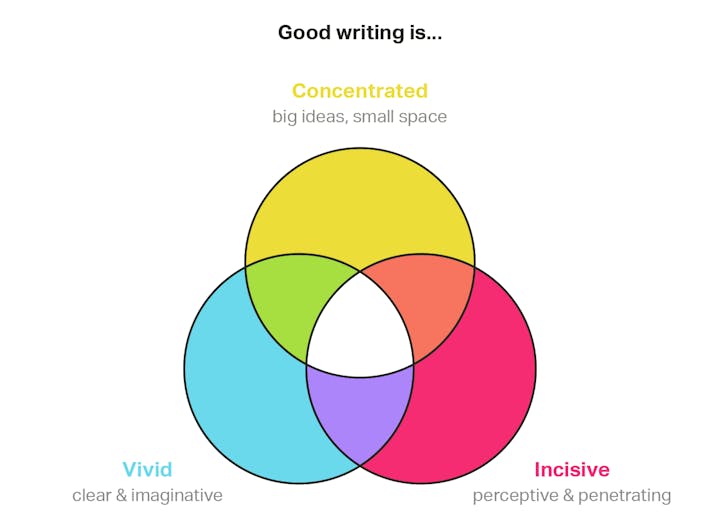Great Content Is Still the Biggest Hurdle


Ever since American poet John Godfrey Saxe penned the idiom back in 1869, we’ve been warned that nobody wants to see how the sausage is made. That is, unless you’re hoping to make your own.
Content creation is messier behind the scenes than most people realize. Perfect systemization just isn’t possible, but there are ways to keep the bar of quality in a sturdy place.
Try the customer support platform your team and customers will love
Teams using Help Scout are set up in minutes, twice as productive, and save up to 80% in annual support costs. Start a free trial to see what it can do for you.
Try for free
Find editorial alignment on quality
Style guides are created to ensure what’s published sounds like it’s coming from the same place, but not from the same person. However, you need alignment on more than Oxford commas and em dash spacing. You need to define what great writing means to you.
This is a collaborative process that will evolve over time, but beginning to define your editorial values doesn’t have to be complicated. You’re looking for distinct but connected principles around who you’re publishing for (customers), what you believe as a company (values, vision), and how you’d like to communicate your ideas.
Let’s look at the latter. At Help Scout, we roughly define thoughtful content with a venn diagram that represents a trifecta of traits.

Is my writing concentrated?
Brevity is not nearly enough, because shallow thoughts can be expressed concisely. Writing gains potency through precision, so your aim is to distill big ideas with as few words as possible.
Concentrated prose is the result of continually asking, “Can this section/paragraph/sentence be condensed further?” And perhaps more importantly, “Does this need to be said at all?”
'Who cares?' I ask it every sentence I write: 'Who cares?' That can be on my tombstone.
Stona Fitch
Is my writing vivid?
This is the tricky art of being unquestionably clear and memorably imaginative. Reframing can turn an accurate statement into a timeless one. Fortunately, there are a few tools you’re already familiar with to ensure you’re writing is clear and compelling.
1. Teach through analogy and metaphor. As engineer Charles Scalfani notes, finding common ground, like teaching abstract concepts using familiar analogies, is how teachers (and writers) effectively communicate their ideas.
2. Fill in the information gaps for readers. Good explanations start by understanding who you’re writing for, what their expertise is, and then filling the gaps between what you know and what they need to know. As author and New Yorker columnist John McPhee writes, “You will never land smoothly on borrowed vividness.” You can’t expect obscure references or insider lingo to do your writing for you.
3. Use visuals to capture your ideas. Just about everyone has stumbled over a confusing passage in a textbook, only to have clarity restored thanks to “See Fig. A.” While learning styles are complete bunk, you don’t need research to know it's often easier to drive a point home with a chart, graphic or illustration.
Is my writing incisive?
This is the most difficult facet to achieve, because it has more to do with thinking than writing. As if insight wasn’t hard enough, you also have to be comfortably certain you’re addressing a topic your audience cares about; producing “cult classics” isn’t an advisable content marketing strategy. As Martin Weigel says, being interesting is more important than being different.
On the first challenge — validating your idea — start by asking: what about the content makes it uniquely (your company) and uniquely you? Next, do your homework. Has your idea been done before in the same way? If so, how can you expand on it to make it yours? As my teammate, Emily, shared in a recent post about coming up with blog ideas, "Never once has an idea I’ve had for a post taken shape from a single source (or ended up like I expected it to when I started out, for that matter)."

To tackle the second challenge — validating your audience — think about the potential reach of a topic (and its slant) as determined by how many people have the problem, how tough the problem really is, and how many great answers currently exist.
Whether you have lifelong experience or it’s newly acquired (say, from a recent project), thinking about your audience is useful for carving out a specific angle. Say you’re leading a big product launch for the first time — instead of an aimless brain dump that gives “okay” tips on myriad topics, acute, tightly packaged advice about a single big problem (Getting organized? Prioritization? Messaging?) will be more popular and much more useful. Base audience isn’t just about prominence; it helps you pursue quality, too.
Stay focused on the content’s objective and incentive

The introduction to any piece of writing should serve as the guidepost to an intended destination. One useful way to find and keep focus is to define author objective and reader incentive for each introduction you write.
1. Author objective: What point are you making?
2. Reader incentive: Why will people care?
Of course, you shouldn’t spell it out like a 3rd grade book report (“The reason I wrote this blog post is because…”). Strong statements written in plain language will get the job done, as they always have. But writing advice is a dangerous gift, so I should at least practice what I preach. Here’s an example from a post on the Help Scout blog.

Introductions vary in form and function; one size can’t fit all. But stating the objective and incentive will help surface the core ideas in your piece and force you to support those ideas throughout the rest of the article.
This mirrors the iron rule of journalism: Put the lead up front. “Don’t bore us, get to the chorus” is on the mind of every reader you’ll never meet. Don’t leave them wondering what your point is; tell them immediately with language that commands attention.
This exercise is universally valuable, because it trickles down from the first time you suggest the article idea to when you craft the subject line before hitting publish. Knowing what you’re saying and why people will care makes framing your content far easier.
Use article archetypes for creative consistency
We’ve written before that “article archetypes,” or reusable ways to tell a good story, bring order to the chaos of content creation. The archetypes we use probably wouldn’t shock you, but that isn’t what’s important — what matters is why each archetype exists.

Creating archetypes involves concretely defining what a certain archetype does well and why it helps your publishing. Let’s look at one we’ve been developing recently: interviews. A classic format, but it does specific and deliberate jobs for us, namely the following:
Interviews help us share good ideas on topics our customers care about, but ones we have less experience in. We’ve never had a dedicated education team or a support team with over 100 people. But we can talk to experienced practitioners who do.
Hard-hitting interviews can be the right move for many brands. But support is a discipline with lots to share and not many platforms in which to share it. We prefer to meet somewhere in the middle by giving our interviewee room to speak about their projects without being flanked from all sides.
Each one of our Q&As is tightly edited. This isn’t to cover all the warts of natural conversation, but to be respectful of a reader’s time. Long, breezy interviews are a perfect fit for some publications, but we’re betting on the value of keeping it concise.
If nothing else, article archetypes serve as a good reminder that there are many roads that lead to the same place, but you have to choose which one you’re going to take to get there.
Learn to pull stories where it counts
One of the core benefits of content marketing is the pact of trust you create between publisher and reader: “If you share things worth learning, I’ll listen to what you have to say.”
When it comes time to broadcast something — like a new release or product update — you still have to hold up your end of the bargain. Sometimes “We made this new thing” really is the most effective message, but for the rest, you need a compelling story that your readers will relate to. It’s the difference between driving the shortest distance and taking the scenic route.

Fortunately, there are a few ways to facilitate the dogged pursuit of “great content” even when writing about your product.
Capture the compelling context. Content can provide context between the customer and the feature. Often, plenty of context is needed to help customers understand the feature’s value — to teach about best practices, why it’s worth using, and what results customers can get.
Example: Supercharge Your Support With Data-Driven Smarts, where our customer champ Mo explained the value of finding your “pizza” metric when digging into the data with a feature like Reporting Views.
Share the detailed case study. For as much as content marketers love storytelling, we can put the horse-blinders on when it comes to red-faced debates about what readers want. Just because Help Scout has a large support audience, for example, doesn’t mean they don’t read about anything else. Case studies can often be a triple-threat in this regard: They can break up your publishing schedule with something fresh, they can be tied back to your product/company in some way, and the big ones create a lot of buzz.
Example: The Evolution of the Help Scout Brand, where our co-founder Jared shared the full four-year history of the Help Scout logo, former mascot, and brand style. This was released with the app redesign and company rebrand.
Craft a story around the status quo. Whether or not the feature is a brand new way to do a valuable task, there are often myriad stories to tell on the current trends, debates, and usage of the feature. And if it ties into a swelling trend, ask yourself if you hold an uncommon or contrarian opinion about the way things work or where things are headed.
Example: Customer Support Is More Than High Scores, which was published back when we released Happiness Ratings. Truth is, the most interesting story wasn’t how we built the feature or why, it was how it was commonly being used — incorrectly. That may seem like a weird way to launch, but a lot of readers appreciated the context, and it was a wake up call compared to the typical “We have this feature now.”
“Great content” never stays still
A final, important lesson we’ve learned over the years is that whatever bar you set for content, you can’t expect to stay static while everything around you changes. Teams, products, markets, goals, and archives all change rapidly — a good sign you’re producing quality material is your ability to keep up with all of them.
The Supportive Weekly: A newsletter for people who want to deliver exceptional customer service.